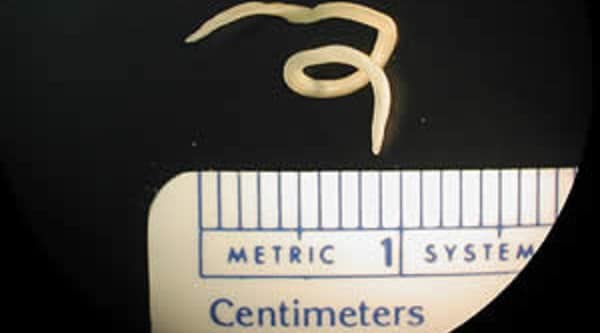Key points
- Healthcare providers can treat anisakiasis by removing the worm via endoscopy or surgery.
- Consider safety precautions of medications in different populations.

Treatment options
It is often possible to diagnose and treat gastric anisakiasis by removal of the worm using an endoscope. Diagnosis of enteric anisakiasis is more difficult; however, it can generally be managed without removal of the worm because the worm will eventually die. Surgery may be required for intestinal or extraintestinal infections when intestinal obstruction, appendicitis, or peritonitis occurs. Successful treatment of anisakiasis with albendazole* 400 mg orally twice daily for 6 to 21 days has been reported in cases with presumptive (highly suggestive history and/or serology) diagnoses.
* Not FDA-approved for this indication
* Oral albendazole is available for human use in the United States.
Care precautions
Treatment in Pregnancy
Albendazole is a pregnancy category C drug. There are limited data on the use of albendazole in pregnant women. The available evidence suggests no difference in congenital abnormalities in the children of women accidentally treated with albendazole during mass drug administration (MDA) campaigns compared with those who were not. In MDA campaigns for which the World Health Organization (WHO) has determined that the benefits of treatment outweigh the risks, WHO allows use of albendazole in the 2nd and 3rd trimesters of pregnancy. However, healthcare providers should balance the risks of treatment for the fetus with the risks of disease progression in the woman in the absence of treatment.
Pregnancy Category C: Either studies in animals have revealed adverse effects on the fetus (teratogenic or embryocidal, or other) plus there are no controlled studies in women, or studies in women and animals are not available. Prescribe albendazole only if the potential benefits to the woman justify the potential risks to the fetus.
Treatment during lactation
Albendazole is minimally excreted in human milk. WHO has concluded that a single oral dose of albendazole can be given to lactating women.
Treatment in pediatric patients
The safety of albendazole in children less than 6 years old is not certain. Studies of the use of albendazole in children as young as one year old suggest that it is safe. According to WHO guidelines for MDA campaigns, children as young as one year of age (able to safely swallow tablets) can take albendazole. These campaigns have treated many children under six years old with albendazole, albeit at a reduced dose.
References
- Hochberg NS, Hamer DH. Anisakidosis: Perils of the deep. Clin Infect Dis 2010;51:806-12.
- Yasunaga H, Horguichi H, Kuwabara K, Hashimoto H, Matsuda S. Clinical features of bowel anisakiasis in Japan. Am J Trop Med Hyg 2010;83:104-5.
- Nakaji K. Enteric anisakiasis which improved with conservative treatment. Intern Med 2009;48:573.
- Pacios E, Arias-Diaz J, Zuloaga J, Gonzalez-Armengol J, Villarroel P, Balibrea JL. Albendazole for the treatment of anisakiasis ileus. Clin Infect Dis 2005;41:1825-6.
- Repiso Ortega A, Alcántara Torres M, González de Frutos C, de Artaza Varasa T, Rodríguez Merlo R, Valle Muñoz J, Martínez Potenciano JL. Gastrointestinal anisakiasis. Study of a series of 25 patients (Spanish). Gastroenterol Hepatol 2003;26:341-6.
- Moore DA, Girdwood RW, Chiodini PL. Treatment of anisakiasis with albendazole. Lancet 2002;360(9326):54.
- Matsui T, Iida M, Murakami M, Kimura Y, Fujishima M, Yao Y, Tsuji M. Intestinal anisakiasis: clinical and radiologic features. Radiology 1985;157:299-302.
This information is provided as an informational resource for licensed health care providers as guidance only. It is not intended as a substitute for professional judgment.
